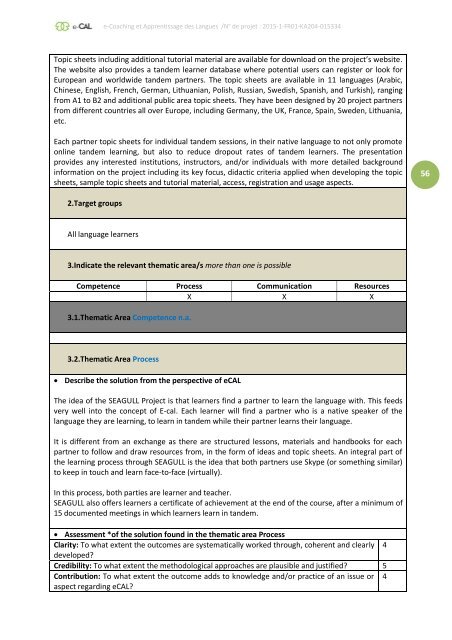e-CAL - e-Coaching et Apprentissage des Langues
The ERASMUS+ project e-CAL presents the result of an analysis of support methods in the case of language learning using web-based Open Educational Resources (OER).
The ERASMUS+ project e-CAL presents the result of an analysis of support methods in the case of language learning using web-based Open Educational Resources (OER).
Create successful ePaper yourself
Turn your PDF publications into a flip-book with our unique Google optimized e-Paper software.
e-<strong>Coaching</strong> <strong>et</strong> <strong>Apprentissage</strong> <strong>des</strong> <strong>Langues</strong> /N° de proj<strong>et</strong> : 2015-1-FR01-KA204-015334<br />
Topic she<strong>et</strong>s including additional tutorial material are available for download on the project’s website.<br />
The website also provi<strong>des</strong> a tandem learner database where potential users can register or look for<br />
European and worldwide tandem partners. The topic she<strong>et</strong>s are available in 11 languages (Arabic,<br />
Chinese, English, French, German, Lithuanian, Polish, Russian, Swedish, Spanish, and Turkish), ranging<br />
from A1 to B2 and additional public area topic she<strong>et</strong>s. They have been <strong>des</strong>igned by 20 project partners<br />
from different countries all over Europe, including Germany, the UK, France, Spain, Sweden, Lithuania,<br />
<strong>et</strong>c.<br />
Each partner topic she<strong>et</strong>s for individual tandem sessions, in their native language to not only promote<br />
online tandem learning, but also to reduce dropout rates of tandem learners. The presentation<br />
provi<strong>des</strong> any interested institutions, instructors, and/or individuals with more d<strong>et</strong>ailed background<br />
information on the project including its key focus, didactic criteria applied when developing the topic<br />
she<strong>et</strong>s, sample topic she<strong>et</strong>s and tutorial material, access, registration and usage aspects.<br />
56<br />
2.Targ<strong>et</strong> groups<br />
All language learners<br />
3.Indicate the relevant thematic area/s more than one is possible<br />
Comp<strong>et</strong>ence Process Communication Resources<br />
X X X<br />
3.1.Thematic Area Comp<strong>et</strong>ence n.a.<br />
3.2.Thematic Area Process<br />
Describe the solution from the perspective of e<strong>CAL</strong><br />
The idea of the SEAGULL Project is that learners find a partner to learn the language with. This feeds<br />
very well into the concept of E-cal. Each learner will find a partner who is a native speaker of the<br />
language they are learning, to learn in tandem while their partner learns their language.<br />
It is different from an exchange as there are structured lessons, materials and handbooks for each<br />
partner to follow and draw resources from, in the form of ideas and topic she<strong>et</strong>s. An integral part of<br />
the learning process through SEAGULL is the idea that both partners use Skype (or som<strong>et</strong>hing similar)<br />
to keep in touch and learn face-to-face (virtually).<br />
In this process, both parties are learner and teacher.<br />
SEAGULL also offers learners a certificate of achievement at the end of the course, after a minimum of<br />
15 documented me<strong>et</strong>ings in which learners learn in tandem.<br />
Assessment *of the solution found in the thematic area Process<br />
Clarity: To what extent the outcomes are systematically worked through, coherent and clearly 4<br />
developed?<br />
Credibility: To what extent the m<strong>et</strong>hodological approaches are plausible and justified? 5<br />
Contribution: To what extent the outcome adds to knowledge and/or practice of an issue or 4<br />
aspect regarding e<strong>CAL</strong>?


